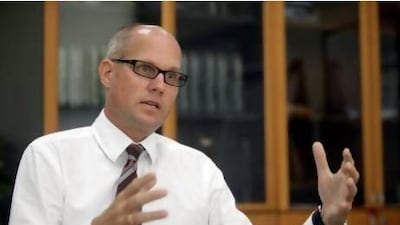ABU DHABI // Police and other authorities will have direct access to an electronic system that monitors injuries and fatalities in the emirate’s hospitals.
The system was launched in October last year. Since January, all hospitals have been required to report cases of injury and poisoning to the Health Authority Abu Dhabi (Haad).
The Injury and Poisoning Notification System (IPNS) enables Haad to collect, analyse and report data from healthcare centres, said Dr Jens Thomsen, head of occupational and environmental health at Haad.
“We are not randomly sampling some data but mandating that all injury data is complete, which is quite unique,” Dr Thomsen said. “Similar systems in other countries rely on a sample.”
The information will help to develop preventive measures by identifying where and when accidents happen, and who is most at risk.
“The data will be used by Haad to plan, develop and implement our activities,” Dr Thomsen said. “Other stakeholders play their own role and part in road-traffic injuries prevention and there will be linkages.”
Dr Asma Al Mannaei, manager of community health and surveillance at Haad, said injury prevention was one of the top 10 priorities for the public health division.
“We are also working on improving the utilisation of our data,” Dr Al Mannaei said. “We’re looking into other government entities and stakeholders who are interested.”
Haad is due to sign an agreement with Abu Dhabi Police, part of which is on data sharing, she said.
“Once that formality is completed we expect this to take place before the end of the year.”
A report using the system showed 59 per cent of deaths caused by injury in the emirate last year were caused by road accidents.
About 303 of 514 injury-related deaths were a result of crashes – an 8.2 per cent drop from 330 in 2011.
Injuries were the second-leading cause of death in the emirate last year, after cardiovascular disease, with 1,136 deaths. Cancer was the third-leading cause, accounting for 475 deaths. The overall rate of fatal injuries decreased significantly from 36.9 deaths for each 100,000 people in 2007 to 22.2 last year.
The decline was largely due to a decrease in the rate of traffic injury-related deaths from 25.3 for each 100,000 in 2007 to 13.6 last year.
“It reflects an improvement in overall road safety as well as a significantly reduced burden on the community with regards to road traffic injuries,” Dr Thomsen said.
The authority is also linking the system with the Ministry of Labour’s occupational injury database so serious and fatal injuries could be better followed up, he said.
Last year there were 71 deaths on worksites – 13.8 per cent of all fatal injuries.
Fatal injuries are only “the tip of the iceberg”, Dr Thomsen said.
The 514 cases of fatal injuries last year accounted for 0.4 per cent of all trauma cases in hospitals.
The IPNS data can also be shared with other sectors and regulatory authorities, including the construction sector, the Industrial Development Bureau and the Abu Dhabi Quality and Conformity Council.
“We are not going after each and every injury. What we look at are trends over time and make statistical analysis,” Dr Thomsen said.
“We will collect and analyse data continuously, and use it as a monitoring tool to assess levels of trends over time.”

